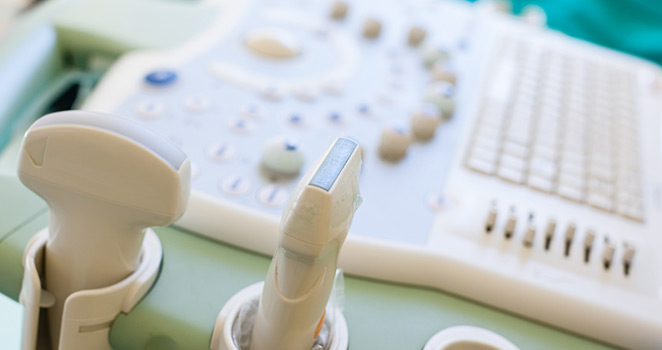Atrium Health Navicent Heart & Vascular Care
Endobronchial Ultrasound Guided (EBUS)

What Is an Endobronchial Ultrasound?
Endobronchial ultrasound (EBUS) is a minimally invasive procedure used to diagnose lung cancer, infections, and various other diseases that can enlarge lymph nodes in the chest. Endobronchial ultrasound guided allows doctors to perform a procedure called transbronchial needle aspiration, or TBNA. A transbronchial needle aspiration involves obtaining tissue or fluid samples from the lungs directly, using it to diagnose and stage lung cancer or other lung diseases like sarcoidosis.
What Are the Advantages of Endobronchial Ultrasound Guided?
Endobronchial ultrasound has obsoleted a more traditional procedure called mediastinoscopy, which requires an incision to be made in the neck. Once the incision has been made, next to the breastbone, a mediastinoscope is inserted into the opening, which allows doctors to collect tissue for biopsy.
In stark contrast, and endobronchial ultrasound and transbronchial needle aspiration require no incisions. The needle aspiration is performed using a bronchoscope, which goes in through the mouth. Because the bronchoscope is equipped with an ultrasound processor, the needle can be guided to where it needs to go.
This ultrasound technology also allows doctors to see the surface of the airways and blood vessels in real time and access small nooks and crannies within these pathways. The needle used is much smaller than with a mediatinoscope, which can be too large and unwieldy. This allows endobronchial ultrasound techniques to be performed much more accurately and precisely.
Because the procedure is relatively painless, there is a need for only a small amount of sedation and anesthesia. Biopsy samples are obtained immediately while the patient recovers quickly and returns home.
What Diseases Can Endobronchial Ultrasound Guided Diagnose?
Endobronchial ultrasound is used primarily to diagnose lung cancer. Coupling ultrasound with a bronchoscope, physicians are able to visual the many layers of the bronchial wall, including the mucosa, submucosa, and the cartilage in the bronchial.
Because of the level of detail afforded by this technique, lung cancer tumors can be detected, diagnosed, and staged very accurately and quickly.
Lung and lymph node infections can also be diagnosed, as the tissue extracted by the process can be biopsied for any number of diseases, including inflammatory lung diseases.
EBUS is sometimes used to diagnose heart diseases by acquiring tissue from pulmonary nodules for biopsy, though this is a secondary use for the technology.
How Do I Prepare for an Endobronchial Ultrasound?
Your primary care provider will outline the necessary preparations you will need to make for your endobronchial ultrasound.
He or she will most likely give you a complete physical examination to determine the appropriateness of EBUS. This will look for overall health and possible symptoms to be diagnosed.
You will most likely be asked to abstain from eating or drinking for 24 hours prior to the procedure for the most accurate readings.
Arrive early for your procedure and bring a family member or friend. You will be mildly sedated and unable to return home alone.
Is Endobronchial Ultrasound safe?
Most physicians consider EBUS very safe, but this is according to anecdotal reports. The technology is currently too new to be assessed statistically--there have not been enough patients who have undergone the procedure to derive meaningful data.
Experienced practitioners of EBUS report extremely low rates of complications caused by endobronchial ultrasound guided.
As with all other invasive procedures or surgeries, those who undergo endobronchial ultrasound are subject to the risk of infection or slight trauma to affected tissues.
How Long Is the Recovery Period for Endobronchial Ultrasound?
The recovery period after EBUS is nearly negligible as most patients are discharged the day of their procedures. Some patients report some soreness.
Because patients still undergo some sedation and moderate anesthesia, they should not be expected to be able to return home by themselves.
What Are the Limitations of Endobronchial Ultrasound?
Endobronchial ultrasound is superior to mediastinoscopy in most ways, but it is still unable to visualize the entire mediastinum. EBUS is able only to give physicians a full view of the anterosuperior mediastinum, and further procedures might be employed for a fuller picture.
Because it is a newer technology, endobronchial ultrasound guided is also extremely difficult to perform, particularly in the upper lymph nodes. Guiding the needle to puncture the correct locations is particularly difficult in the elderly because of cartilage calcification. This issue should resolve itself as physicians acquire more and more experience with the technique.
Endobronchial ultrasound is also quite expensive to set up for a hospital. The suite of equipment required may cost thousands of dollars, and hospitals are generally not reimbursed for more than the standard bronchoscopy, despite its efficacy.
What Does This Mean for Non-Small Cell Lung Cancer?
Non-small cell lung cancer is considered the most manageable of two major types of lung cancer. Its early detection has long been coveted because early (Stage I or II) non-small cell lung cancer is often curable.
Detection of these early stage lung cancers has primarily been accidental, however, as symptoms of lung cancer do not generally appear until the late stages when it is too advanced to cure.
With the advent of endobronchial ultrasound, it might become easier to screen for and diagnose those with early stages of non-small cell lung cancer for a more effective treatment and possible cure.
The American Cancer Society has outlined the following conditions for those who should be looking for lung cancer screening:
- 55 to 74 years old
- In fairly good health
- Have at least a 30 pack-year smoking history
- Are either still smoking or have quit smoking within the last 15 years
This means that a great portion of the American population may have a use for an endobronchial ultrasound for the sake of diagnosis.